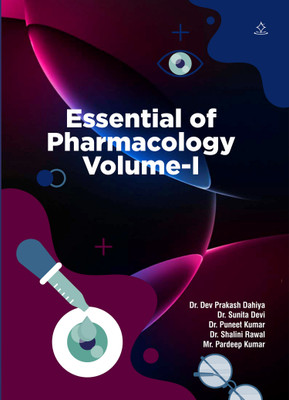ESSENTIAL OF PHARMACOLOGY - Volume-I(Paperback, Dr. Dev Prakash Dahiya, Dr. Sunita Devi, Dr. Puneet Kumar, Dr. Shalini Rawal, Mr. Pardeep Kumar)
Quick Overview
Product Price Comparison
Essentials of Pharmacology Volume-I is a comprehensive text designed to provide students with a strong foundation in the science of drugs, their mechanisms, actions, and therapeutic applications. It begins with General Pharmacology-I, introducing the subject by defining pharmacology, tracing its historical landmarks, and explaining its broad scope in medicine and healthcare. The section outlines the nature and sources of drugs, the concept of essential drugs, and the various routes of drug administration. Fundamental terms like agonists, antagonists, spare receptors, addiction, tolerance, dependence, tachyphylaxis, idiosyncrasy, and allergy are explained to set a conceptual base. The part on pharmacokinetics gives a detailed account of how drugs move through the body, covering membrane transport, absorption, distribution, metabolism, and excretion, along with important concepts like enzyme induction, inhibition, and kinetics of elimination. Moving forward, General Pharmacology-II emphasizes pharmacodynamics, describing the principles and mechanisms of drug action, receptor theories, types of receptors, and regulation of receptors. Signal transduction mechanisms such as G-protein coupled receptors, ion channel receptors, enzyme-linked receptors, JAK-STAT pathways, and nuclear transcription factor regulation are discussed thoroughly. This section also explores doseŌĆōresponse relationships, ther. peutic index, combined drug effects, and factors modifying drug action, giving learners insight into how drugs exert their effects in real systems. It then explains adverse drug reactions, drug interactions (both pharmacokinetic and pharmacodynamic), and the process of drug discovery and evaluation, including the preclinical phase, clinical trial phases, and pharmacovigilance . The third major unit focuses on the pharmacology of drugs acting on the peripheral nervous system, detailing the organization and function of the autonomic nervous system, mechanisms of neurohumoral transmission, co-transmission, and classification of neurotransmitters. Specific drug groups like parasympathomimetics, parasympatholytics, sympathomimetics, and sympatholytics are explained with their mechanisms and uses. Also covered are neuromuscular blocking agents, skeletal muscle relaxants, local anesthetics, and drugs used in myasthenia gravis and glaucoma, which are vital for both therapeutic and surgical practices. The book then turns to the central nervous system in two parts.


